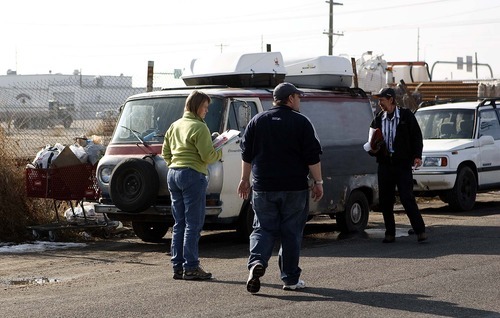This is an archived article that was published on sltrib.com in 2011, and information in the article may be outdated. It is provided only for personal research purposes and may not be reprinted.
Utah's homeless population shrank by 8.2 percent between January 2010 and this January, Lt. Gov. Greg Bell and other state officials announced Wednesday.
The number of chronically homeless, defined as those who have been homeless for more than a year, dropped by 26 percent.
Bell attributed the drop to Utah's Housing First Initiative, a collaboration between government, nonprofit and private agencies that has built hundreds of units in permanent supportive communities since 2005 and is planning still more.
"We want to end chronic homelessness," Bell said.
This year's estimates are based on the January 27 Point-in-Time count, an annual effort by state, public, private and nonprofit homeless service providers to seek out homeless Americans.
The count is required by the U.S. Department of Housing and Urban Development. HUD defines homeless as people who are sleeping in places not meant for human habitation, sleeping in emergency shelters or living in transitional housing but were previously living on the streets.
The survey is part of the state's 10-year plan to reduce chronic homelessness, an effort that began in 2006, when 13,362 people were homeless statewide. Of those, 1,914 were chronically homeless, according to Jayme Day, planning director for the Utah State Community Services Office.
By 2010, the number of people who experienced homelessness for some or part of the year had grown to 15,642, most of whom were re-housed within a short time. The number of people considered chronically homeless, however, had shrunk to just 812.
In 2011, 14,351 Utahns statewide had experienced homelessness; 601 of them chronically.
Gordon Walker, who heads the state Division of Housing and Community Development, said this past winter was remarkable in that the main shelter in downtown Salt Lake City had excess capacity almost every night.
"This year, not one single person was bused to the Midvale [overflow] winter shelter," he said. By comparison, 270 people were taken to Midvale two years ago.
While the chronically homeless make up only about 5 percent of the overall total, they use 50 percent of the shelter, emergency service and other resources providers would rather reserve for families.
Under the state's plan to end chronic homelessness, people go from the streets or shelters into their own affordable, permanent apartments where they pay 30 percent of their income for rent. Some of the apartments provided to the homeless are together in the same building; others are scattered through the community. The plan also includes job training and other services to help formerly chronic homeless people integrate into their new surroundings.
"You may not know," Walker said, "that the person living next to you has been homeless." Utah homelessness on the wane
Midway through the state's 10-year effort to reduce homelessness, the annual January homeless census shows the number of people living in shelters or on the streets fell 8.2 percent overall since last year, and the number of chronically homeless dropped by 26 percent.
The counts, taken since 2006, showed a spike during the worst years of the recession, 2008 through 2010, and still haven't dropped to the low of 2007, according to numbers provided by the Utah Department of Community and Culture and Division of Housing and Community Development.



